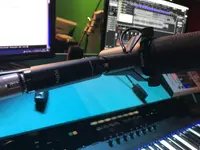rob aylestone
Moderator
We've discussed quite recently low output mics, and the Cloudlifters and similar devices that get the output up to more useful levels to let the preamps in the interfaces have an easier time.
I got a random email from Studiospares here in the UK advertising the Imperative Audio FET Pre FP1. I'd been pretty insistent about my luke warm impression of the SM7B, so figured that buying a preamp would at least be worth a try. I recorded the mic at about 2" from my lips to the foam, and on the gain setting I use for condensers and the higher output dynamics, the record level was very low. My plan was then to normalise in Cubase to -3dB, then repeat the test with the preamp. I would normalise that to the same level - so you should hear tonal and noise differences, or not.
I then had a thought. I have a couple of Coles 4104 Commentators mics - the ribbon types you often see being used in difficult locations on TV. These are lower in output than the SM7B - so I repeated the test.
I have to say I can hear a difference, and frankly, I did not believe some of the recent comments posted about the benefit a preamp can do. I was wrong. The SM7B is better with the preamp and the same difference appears on the commentators mic.
48K wav 32 bit recording done in cubase - only normalisation applied - nothing else. Comments, even "I told you so" gratefully received.
file here
I got a random email from Studiospares here in the UK advertising the Imperative Audio FET Pre FP1. I'd been pretty insistent about my luke warm impression of the SM7B, so figured that buying a preamp would at least be worth a try. I recorded the mic at about 2" from my lips to the foam, and on the gain setting I use for condensers and the higher output dynamics, the record level was very low. My plan was then to normalise in Cubase to -3dB, then repeat the test with the preamp. I would normalise that to the same level - so you should hear tonal and noise differences, or not.
I then had a thought. I have a couple of Coles 4104 Commentators mics - the ribbon types you often see being used in difficult locations on TV. These are lower in output than the SM7B - so I repeated the test.
I have to say I can hear a difference, and frankly, I did not believe some of the recent comments posted about the benefit a preamp can do. I was wrong. The SM7B is better with the preamp and the same difference appears on the commentators mic.
48K wav 32 bit recording done in cubase - only normalisation applied - nothing else. Comments, even "I told you so" gratefully received.
file here



